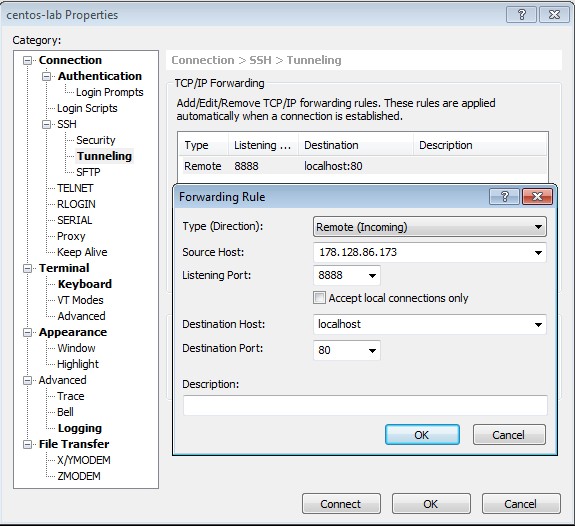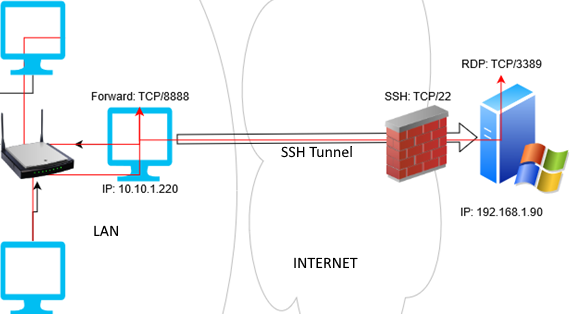
For example, you might enter “if you’d like your tunnel to send its traffic to the http port on the host Next fill in the “Destination” field, enter the destination hostname or IP, followed by the destination port number.Under “Source port” put down the local port number you want to connect to for forwarded traffic.Click through “Connection” > “SSH” > “Tunnels” from the “Category” panel.For “Host Name”, enter the hostname / domain or IP of the server you want to connect to.Follow these steps to set up an SSH tunnel with PuTTY::
#WINDOWS SSH TUNNEL ALL TRAFFIC PASSWORD#
You will also need the hostname or IP address of the remote SSH server, as well as the username and password (or other authentication method) for an account on that server. To use SSH tunneling with PuTTY, you will need to have a working installation of PuTTY on your computer.

#WINDOWS SSH TUNNEL ALL TRAFFIC HOW TO#
In a future article, we will go through how to use Putty to establish a socks proxy as another sort of tunneling. Under this approach, all other traffic would proceed normally, and in order to use the tunnel, you would need to directly connect to the tunnel’s local IP address and port. This article will describe one kind of static SSH tunneling, in which every communication that passes through the tunnel is forwarded to a certain destination host. This is useful for applications like MySQL where remote server access is necessary, but the application’s default means of remote access is less secure than SSH. SSH tunneling, also known as SSH port forwarding, maps a local IP and port to a remotely accessible resource, allowing local applications to make remote connections in a secure manner. 2 Follow these steps to set up an SSH tunnel with PuTTY::Īn SSH Tunnel provides an encrypted connection between a local computer and remote server using the SSH protocol.To enjoy DNS services on your local machine, put the following line as first nameserver in your /etc/nf: nameserver 127.0.0. on local UDP port 53, it will be forwarded to local TCP port 6667, then to server's TCP port 6667, then to server's DNS server, UDP port 53 of 192.168.1.1. This will allow UDP traffic on local machine's port 53 to be forwarded to TCP traffic on local machine's port 6667.Īs you've probably guessed, when a DNS query will be performed on the local machine, e.g. You need priviledged access to bind the UDP port 53. Now, we need to do the opposite of what was done above on the local machine. Setup the UDP to TCP forward on your machine This will allow TCP traffic on server's port 6667 to be forwarded to UDP traffic on 192.168.1.1's port 53, and responses to come back. A simple shell pipe would only communicate left process' standard output to right process' standard input. The fifo is necessary to have two-way communications between the two channels. If you want to do DNS forwarding like me, you can take the first nameserver's IP you will find in /etc/nf.īut first, we need to create a fifo.

On the server, we open a listener on the TCP port 6667 which will forward data to UDP port 53 of a specified IP. Setup the TCP to UDP forward on the server This will allow TCP connections on the port number 6667 of your local machine to be forwarded to the port number 6667 on through the secure channel. On your local machine (local), connect to the distant machine (server) by SSH, with the additional -L option so that SSH will do TCP port-forwarding: local# ssh -L 6667:localhost:6667 Performing UDP tunneling through an SSH connection Step by step Open a TCP forward port with your SSH connection

This small guide tells you how to send UDP traffic via SSH using tools that come standard (ssh,nc,mkfifo) with most UNIX-like operating systems.


 0 kommentar(er)
0 kommentar(er)
